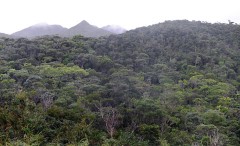Amami and Ryukyu islands on World Heritage list

On October 15, 2010, evergreen broad-leaved trees such as Castanopsis sieboldii grow in the Yambaru Forest in the Kunigami region.
February 1, 2013 Ryukyu Shimpo
On January 31, at a meeting of the Inter-Ministerial/Agency Co-ordination Committee for World Natural Heritage held at the Foreign Ministry, the Japanese government decided to apply for the inclusion of the Amami and Ryukyu islands on UNESCO’s provisional list of candidates for World Heritage sites. Islands in Kagoshima and Okinawa prefectures were selected as candidates for World Heritage sites in 2003. The inclusion on the list is part of the process for officially recommending the islands to become World Heritage sites. The Environment Ministry is keen to secure World Heritage status for the islands, and if they are registered by the U.N. Educational, Scientific and Cultural Organization as World Natural Heritage sites, it will be Japan’s fifth listing. This is the first time in six years that sites in Japan have been included on UNESCO’s provisional list, the last being the Ogasawara Islands, which were registered as World Natural Heritage sites in June 2011.
There are still two major screening processes before sites are officially registered, but Okinawan people’s dream of registration of the islands has now made major progress ten years after the islands were selected as candidates.
The government will submit the list to the UNESCO World Heritage Centre in the near future, and is prepared to submit the necessary documents, including those designating the recommended areas.
Submission of the documents for recommendation is expected to take some time because land has to be converted into national parks, and the protected areas have to be designated and expanded. These steps are prerequisites in the process for recommendation.
Reiji Kamesawa, the head of the Biodiversity Policy Division of the Nature Conservation Bureau of the Ministry of the Environment talked to the press after the committee meeting, saying, “Full registration will take three years at the earliest.” It took three years for the recommendation documents for the Ogasawara Islands to be submitted after their inclusion on the list in January 2007, and four years for full registration to be completed.
The Amami-Ryukyu region is inhabited by relict species, that is, species that are thought to have been more widespread in the past than now. Such species have a discontinuous breeding distribution, usually because of climatic change. They have evolved in their own way in the process of the continuous separation and merging of the islands. The government rates the islands highly because rare species included in the International Union for Conservation of Nature Red List of Threatened Species inhabit the islands, and it is important to preserve the biodiversity there.
Previous Article:Physically challenged travel abroad
Next Article:Eight professional baseball teams visit Okinawa for training camps
[Similar Articles]
- World Natural Heritage – Yambaru and Iriomote to go on World Natural Heritage prospective list
- After Okinawa and Amami made the World Natural Heritage List, Governor Tamaki affirms they need to “Make it last 1,000 years”
- Okinawa to implement policy to limit the number of people who can enter Iriomote Island, which may become a World Natural Heritage Site
- Biodiverse island areas in northern Okinawa nominated for UNESCO World Natural Heritage
- Ministry of Environment says disclosure of Yambaru world heritage documents would damage relationship of trust with US military
 Webcam(Kokusai Street)
Webcam(Kokusai Street)


